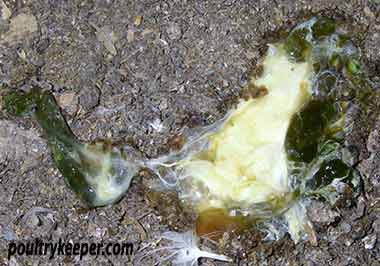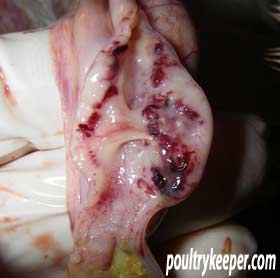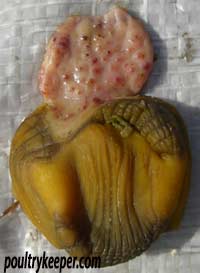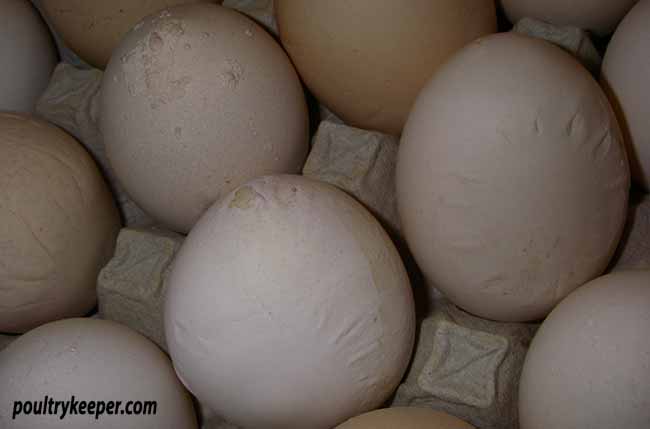Newcastle disease was first found in Newcastle-upon-Tyne in 1926.The disease is caused by a virus called Avian Paramyxovirus Type 1.
Whilst we tend to think of Newcastle disease as being associated with large numbers of dead birds it is important to remember that the disease varies from lentogenic (moderately pathogenic) strains which cause mild respiratory disease and low mortality through to velogenic (highly pathogenic) strains which are associated with high mortality.
The velogenic strains cause high mortality (up to 100%) and spread rapidly causing respiratory and nervous signs. These strains can be subdivided further:
- Viserotrophic velogenic strains which cause bloody (haemorrhagic) damage to the intestine.
- Neurotrophic velogenic strains tends to develop rapidly and is usually fatal in birds of all ages. Affected birds usually show some respiratory signs along with nervous signs which manifest themselves as a twisting of the head and neck (torticollis). Intestinal damage tends to be absent.
- Mesogenic strains can result in coughing, cause problems with egg quality and production and usually result in lower (around 10%) mortality.
- Lentogenic strains usually cause mild respiratory signs and are rarely fatal. These strains are commonly used in Newcastle Disease vaccines.

Newcastle disease is highly contagious and can affect poultry of all ages. Many species (over 250) of bird can be affected including; chickens, turkeys, pigeons and ducks. The disease is rarely diagnosed in ducks but can be a possible cause of production and or fertility problems. Rarely, other species can be infected, including mammals (e.g. causing conjunctivitis in man and mild flu-like symptoms)
Spread is usually via the air (aerosol), or through birds eating contaminated faeces. The actual route is dependent on the clinical signs being exhibited in the affected birds: aerosol if respiratory; faeces if the intestinal tract is involved. Transmission through the egg does not occur, however, young chicks can be exposed to virus that is on the egg shell resulting in the development of disease. Humans play a central role in the spread of the disease.

The virus is also very resilient and can survive for long periods (up to 12 months) within faeces and dust in a poultry house. As a result, as with most diseases, cutting corners during cleaning and disinfection can have disastrous results. We recommend a powerful disinfectant such as Interkokask.
The clinical signs in affected birds can be very variable. Signs can range from the sudden onset of high mortality through to a mild disease with respiratory symptoms or a drop in egg production.
Clinical signs can include:

- General depression
- Depressed appetite
- Gaping
- Coughing
- Sneezing
- Nervous signs
- Diarrhoea (usually emerald green)
- Egg drops
- Shelling issues
As with the clinical signs, lesions can vary considerably and also have little value in the diagnosis of Newcastle disease. The photos following show some of the lesions identified in birds that were later confirmed to have Newcastle disease.
Samples have to be analysed at a laboratory to confirm disease. This usually consists of swabs taken from the trachea and cloaca as well as faeces samples from suspected birds.
 An example of some of the shelling issues attributable to Newcastle disease.
An example of some of the shelling issues attributable to Newcastle disease.
Control
No treatment for the disease exists. In recent years the control of Newcastle disease in EU countries has been tackled by a series of legislative directives. These directives lay out the definition of disease, the measures to prevent introduction and spread, and the method of removing disease should an outbreak occur.
Farm control is hinged upon biosecurity and vaccination:
Biosecurity
As with all other diseases, thorough cleaning and disinfection can reduce or evenprevent any challenges from the disease. Careful sourcing of new stock is vital to avoid buying in disease.
Vaccination
Vaccination is available for flocks especially commercial flocks. However factors such as cost and risk of the disease need to be borne in mind. Certain vaccine strains can cause reactions in the birds.
If you suspect your birds remember it is a NOTIFIABLE DISEASE. This means, if it is diagnosed, the infected poultry will be culled. Controlled zones around the outbreak will be set up to limit and prevent further spread of disease. If you suspect that your birds are suffering from any of the clinical signs mentioned then it is important to contact your vet immediately.




